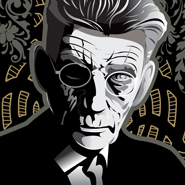Posted: 17 July 2012
Beckett and the ‘State’ of Ireland
“Much of the apparently surrealistic in Beckett’s writing is linked, sometimes forcefully, often only tenuously, with the reality of existence, and much of this actuality emanates from his memories of Dublin - a world which he renders almost unrecognisable as he removes reality from his landscape and its people in his creation of what has been called the unreality of the real,” says Professor Eoin O’Brien who first met Samuel Beckett in the 1970s while researching for his book The Beckett Country: Samuel Beckett's Ireland.
Written to celebrate Samuel Beckett's eightieth birthday (1986), the book was a response by Professor O’Brien to the growing critical literature on Beckett’s writings which failed to recognise his Irishness and, as a consequence, his humour.
It charts the landscape of the novels, plays and poetry of Samuel Beckett, and is illustrated with black and white photographs by David H. Davison of various locations around Ireland.
According to O’Brien, the geographical extent of ‘The Beckett Country’ is confined almost entirely to the city of Dublin, and the surrounding County; most especially Foxrock, and the coast of Dún Laoghaire, Killiney and Sandyford.
“The heart of ‘The Beckett Country’ lies in the magic landscape of the Dublin Mountains,” he says.
As part of the “Beckett and the ‘State’ of Ireland Conference” (12-14 July) hosted by the UCD Humanities Institute, a photographic exhibition, based on the illustrations and text from the book, which was designed and compiled by Professor Eoin O’Brien and the Department of Topography and Design at Reading University (1986), with the assistance of James Knowlson and David Davison, was on public display in UCD’s Ardmore House.
| Listen to Prof Eoin O'Brien at the Beckett and the 'State' of Ireland Conference hosted by UCD Humanities Institute for Ireland |
|---|
|
-- The media which displays here may not be supported by your browser --
|
The exhibition, which has been on display across the world, is now on permanent loan to the James Joyce Library, University College Dublin.
Digital representations of the book and the exhibition are accessible at the Irish Virtual Research Library and Archive (IVRLA) at University College Dublin.
The IVRLA is a digital Humanities and Social Sciences repository established under the Higher Education Authority’s Programme for Research in Third-Level Institutions. Coordinated under the auspices of the UCD Humanities Institute, it draws on the extensive resources of archival and rare material held in University College Dublin to enable researchers to access material in a digitised format from a single virtual location.(Produced by UCD University Relations)

